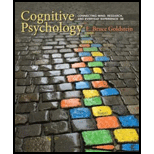
Introduction
Selective attention is a cognitive procedure wherein an individual attends to a sensory input or more while ignoring or avoiding the others, whereas divided attention is one of the higher-level skills wherein one can operate on two or more tasks at a time with all the tasks requiring attention.
Explanation of Solution
Suggested response
Attempting to focus on a science homework while ignoring the conversation of family members demonstrates selective attention, while conversation in students' library being interfered with one's game on his/her cell phone can exemplify distraction. Distraction refers to diverting one's attention from some desired focal area, thereby, diminishing or locking the reception of the desirable material.
Attentional capture occurs when some property of a stimulus attracts the observer's attention which could be accompanied by scanning, which is a process of looking around carefully for detecting some features. Divided attention may include talking to a friend on phone while playing a video game. The attention of an individual, secretly listening to someone else's conversation might get distracted due to the noise of an overspeeding car. Attempting to identify people's face in a room by looking from one face to another represents the process of scanning.
Want to see more full solutions like this?
Chapter 4 Solutions
Cognitive Psychology
- how do social media platforms often dictate trends in fashion, music, and lifestyle, significantly shaping consumer behavior.arrow_forwardCan users often present idealized versions of themselves, which can lead to unrealistic comparisons and impact self-esteem?arrow_forwardCan excessive use of social media has been linked to increased levels of anxiety, depression, and loneliness, particularly among younger users?arrow_forward
- How exposure to diverse cultures and ideas broadens one's perspective of the world, yet it can also result in cultural appropriation or homogeneity?arrow_forwardHow to develop a proposal outline with examples on How Social Media Influences Human Behavior.arrow_forwardWhile reading this article can you explain strong point , weaknesses point an future study https://doi.org/10.1126/science.1182238arrow_forward
- What are your thoughts of this article https://doi.org/10.1126/science.1182238arrow_forwardWhile readings this article what does this explain about the people https://doi.org/10.1126/science.1182238arrow_forwardMake a graph based on this data below : based on group A and Group B Group A (Bilingual): Vocabulary Task Response Times (seconds): [1.1, 1.3, 1.2, 1.0, 1.4, 1.3, 1.2, 1.1, 1.0, 1.2] Sentence Construction Task Response Times (seconds): [2.0, 2.1, 1.9, 1.8, 2.2, 2.1, 1.7, 2.0, 1.8, 1.9] Group B (Monolingual): Vocabulary Task Response Times (seconds): [1.5, 1.6, 1.5, 1.4, 1.7, 1.5, 1.8, 1.6, 1.5, 1.6] Sentence Construction Task Response Times (seconds): [2.5, 2.6, 2.5, 2.7, 2.4, 2.6, 2.7, 2.5, 2.5, 2.6] 2. Outcome of the Experiment The outcome showed that bilingual individuals performed better, with faster response times in both vocabulary retrieval and sentence construction tasks compared to monolingual individuals. 3. Descriptive Statistics Group A (Bilingual): Vocabulary Task: Mean: Mean=10(1.1+1.3+1.2+1.0+1.4+1.3+1.2+1.1+1.0+1.2)=1.21s Standard Deviation (SD): SD≈0.11s Sentence Construction Task: Mean: Mean=10(2.0+2.1+1.9+1.8+2.2+2.1+1.7+2.0+1.8+1.9)=1.99s SD:…arrow_forward
- In this article, can you explain each of the three games ultimatum game, the dictator game, and the party punishment game? Also, how many days did they play the game, and did people know about it? https://doi.org/10.1126/science.1182238arrow_forwardIn this article can you describe the fairness an punishment for market, religion and community https://doi.org/10.1126/science.1182238arrow_forwardIn this article what was the advantage an disadvantage of this article and what was the point of the article. https://doi.org/10.1126/science.1182238arrow_forward
 Ciccarelli: Psychology_5 (5th Edition)PsychologyISBN:9780134477961Author:Saundra K. Ciccarelli, J. Noland WhitePublisher:PEARSON
Ciccarelli: Psychology_5 (5th Edition)PsychologyISBN:9780134477961Author:Saundra K. Ciccarelli, J. Noland WhitePublisher:PEARSON Cognitive PsychologyPsychologyISBN:9781337408271Author:Goldstein, E. Bruce.Publisher:Cengage Learning,
Cognitive PsychologyPsychologyISBN:9781337408271Author:Goldstein, E. Bruce.Publisher:Cengage Learning, Introduction to Psychology: Gateways to Mind and ...PsychologyISBN:9781337565691Author:Dennis Coon, John O. Mitterer, Tanya S. MartiniPublisher:Cengage Learning
Introduction to Psychology: Gateways to Mind and ...PsychologyISBN:9781337565691Author:Dennis Coon, John O. Mitterer, Tanya S. MartiniPublisher:Cengage Learning Psychology in Your Life (Second Edition)PsychologyISBN:9780393265156Author:Sarah Grison, Michael GazzanigaPublisher:W. W. Norton & Company
Psychology in Your Life (Second Edition)PsychologyISBN:9780393265156Author:Sarah Grison, Michael GazzanigaPublisher:W. W. Norton & Company Cognitive Psychology: Connecting Mind, Research a...PsychologyISBN:9781285763880Author:E. Bruce GoldsteinPublisher:Cengage Learning
Cognitive Psychology: Connecting Mind, Research a...PsychologyISBN:9781285763880Author:E. Bruce GoldsteinPublisher:Cengage Learning Theories of Personality (MindTap Course List)PsychologyISBN:9781305652958Author:Duane P. Schultz, Sydney Ellen SchultzPublisher:Cengage Learning
Theories of Personality (MindTap Course List)PsychologyISBN:9781305652958Author:Duane P. Schultz, Sydney Ellen SchultzPublisher:Cengage Learning





